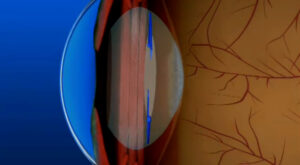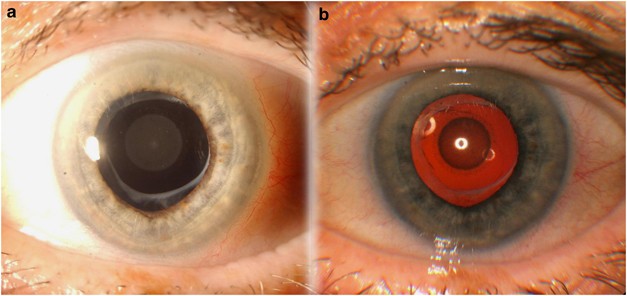A lamellar cataract is the most common type of cataract, and the most benign. It usually affects both eyes at about the same rate and can develop gradually over time or suddenly. Lamellar or zonular cataracts are a type of hereditary cataract that is transmitted in an autosomal dominant mode. The opacities are located at the level of the primary fibers in the embryonic nucleus, and it is usually bilateral and asymmetrical.
Contents
What Is Lamellar Cataract?

A lamellar cataract is a type of congenital cataract that is characterized by thin, minute layers of opacification in the lens of the eye. This condition is usually diagnosed in childhood or early adolescence and can be treated with surgery.
Lamellar cataracts are hereditary and transmitted in an autosomal dominant mode. The crystalline opacities are located at the front of the nucleus, meaning that they affect the fibers that connect to the lens. Usually, it’s bilateral and asymmetrical. However, it can also affect the whole nucleus and cause decreased visual acuity. We report on a 19-year-old patient with unilateral lamellar cataract.
Lamellar cataracts typically affect both eyes but may be more severe in one eye than the other. The degree of visual impairment caused by this condition varies from person to person. In some cases, lamellar cataracts do not significantly impact vision and do not require treatment. However, in other cases, this condition can cause significant vision loss and may require surgical intervention.
What Causes Lamellar Cataracts?
A lamellar cataract is a type of partial cataract that affects only certain parts of the lens. It is caused by changes in the proteins of the lens, which can be due to aging, injury, or other factors.
Developmental cataracts are often inherited in an autosomal dominant pattern. When one parent has them, they can expect that half of their children will also develop them.
Lamellar cataracts are usually detected in the first years of life but may affect babies at birth. That’s why every newborn should have a complete eye examination. Early detection is important to prevent lazy eye (amblyopia).
These types of cataracts often inherit from parents, which is the case for this disorder. Since these cataracts are often progressive, serial monitoring is required so that surgery can be performed at an appropriate time. However, not all need to be removed; it’s common for nearly everyone to have small opacities in their lenses that do not progress and cause no difficulty in seeing.
Zonular cataracts are usually associated with other ocular or systemic diseases, including anisometropia, strabismus, Pearson syndrome, chromosomal anomaly 17 mosaicism, displaced lens tissue, or traumatic events.
This patient with a history of poorly controlled type 2 diabetes had vision loss over the past 5 years, as well as blurry and strong glare. But, on examination, it was also revealed that they have bilateral congenital lamellar and sutural cataracts likely exacerbated by their poor diabetes control.
How Is It Treated?
Lamellar cataracts are treated with surgery to remove the cloudy lens and replace it with an artificial lens. This type of surgery is called phacoemulsification or intraocular lens (IOL) exchange. During this procedure, a small incision is made in the eye and a tiny probe is used to break up the cloudy lens so it can be suctioned out. An IOL is then placed in the eye. Treatment typically involves surgery to remove the affected portion of the lens.
Most people who have this surgery experience little discomfort and have good vision afterward. In some cases, however, there may be complications such as infection, bleeding, or retinal detachment.
There are several types of surgery that can be used to treat lamellar cataracts. The most common type of surgery is called extracapsular cataract extraction (ECCE). This procedure involves making an incision in the side of the eye and removing the affected lens through this opening. A new artificial lens will then be inserted into the eye to replace the removed natural lens.
Another type of surgery that can be used to treat lamellar cataracts is called phacoemulsification. This procedure uses ultrasonic waves to break up the affected lens so that it can be removed from the eye through a small incision. A new artificial lens will then be inserted into the eye to replace the removed natural lens.
The decision on which type of surgery to use will depend on several factors, including the severity of the cataract, the age and health of the patient, and the preference of the surgeon.
Prevention
A lamellar cataract is a type of cataract that develops in the layers of the lens of the eye. It is the most common type of cataract in young people and can be caused by either trauma or genetics. Treatment typically involves surgery to remove the damaged lens and replace it with an artificial one.
Prevention of lamellar cataracts generally focuses on protecting the eyes from injury and avoiding known genetic risk factors. Wearing protective eyewear during activities that could result in eye injury is important, as is avoiding exposure to harmful UV rays. If you have a family history of lamellar cataracts, you may be able to reduce your risk by maintaining good eye health and having regular eye exams.
Conclusion
A lamellar cataract is a type of cataract that affects the back layer of the eye’s lens. It is a slow-growing form of cataract and can be treated with surgery. In most cases, surgery is successful in restoring vision to those affected by lamellar cataracts.
It is a type of cataract that affects the back layers of the eye’s lens. It is treated with surgery to remove the affected lens and replace it with an artificial one. The surgery is typically performed under local anesthesia and takes about an hour. Recovery from the surgery takes a few weeks, during which time you may experience some blurry vision and light sensitivity.
It is treated with a surgery called lamellar keratoplasty, which replaces the damaged tissue with healthy tissue from another part of the eye. This surgery is usually successful in restoring vision and improving the quality of life for those affected by this condition.
Cataract surgery is a safe and painless procedure. At MantraCare we have a team of experienced eye surgeons, who will be happy to answer any questions on cataract surgery. Call us at +91-9711116605 for any inquiries.
